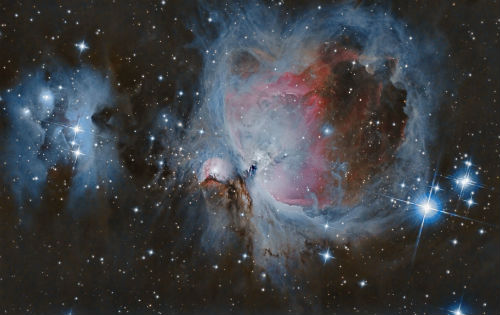
Clear February nights present some great stargazing opportunities. Be sure to bundle up and keep warm while you get outside for some stargazing fun!
Here are a few of Orion's top picks for February stargazing:
Potential Pre-Dawn Comet ? This month northern hemisphere sky-watchers may get a chance to see a comet! Comet 45P/Honda-Mrkos-Pajdu?áková heads for its closest approach to Earth on the 11th. In early February use binoculars to look for a tiny but distinct 8th-magnitude "fuzzball" just above the eastern horizon before dawn. By mid-month it rises before midnight but may be difficult to spot as the waxing gibbous Moon is nearby. Toward the end of February the Moon is out of the way and the comet climbs higher, but it is likely to have dimmed to 12th or 13th magnitude.
Great Binocular Cluster ? Get out your 50mm or larger astronomy binoculars for great views of the Pleiades star cluster (M45), which will be high in the northwestern sky during February. While M45 can be seen with unaided eyes from a rural location with dark skies, the open star cluster is a much more spectacular sight in binoculars or you can use a low-power, wide-field eyepiece in any size telescope.
Our Favorite Nebula ? Throughout February, our namesake constellation Orion will be in a great viewing position for backyard stargazers. Use 50mm or larger binoculars and look in the area below the three recognizable stars of Orion's belt for a great view of M42, the Orion Nebula. For a more detailed view of this stellar nursery, you can use any size telescope, but we recommend a 6" or larger reflector for an immersive experience. If you'll be observing from the city, use an Orion UltraBlock Narrowband Filter to combat light pollution and boost contrast.
Winter Star Clusters ? Look east of constellation Canis Major's brightest star Sirius with a telescope to see two beautiful star clusters, M46 and M47 in the constellation Puppis. For more star cluster observations in February, look in the constellation Auriga to go after sparkling clusters M36, M37 & M38, or M35 in the constellation Gemini.
New Moon ? The New Moon of February 26th promises dark skies for a great, albeit chilly, opportunity to get clear views of the winter Milky Way and various deep space objects in larger telescopes.
Bright Galaxies ? In late February, bright galaxies M81 & M82 will be about as high in the sky as they will get for North American stargazers. From a dark sky site, these galaxies are visible with a 50mm or larger binocular, but we suggest you use a large telescope to chase these galaxies down just off the leading edge of the Big Dipper asterism. Many observers consider M81 & M82 the best pairing of visual galaxies in the sky!
Challenge Object ? In the constellation Monoceros lies the 9th magnitude Hubble's Variable Nebula (NGC 2261), named after the astronomer Edwin Hubble (yes, the same as the Hubble Telescope). While small, this distant reflection nebula is bright enough to be picked out as a pin point of light with 70mm [binoculars]. As the name implies, it does vary in size and brightness since its glow is "powered" by a variable star buried within its nebulosity. What's the smallest telescope you can see it with ? tell us on Facebook!
Talented astrophotographer John Landreneau captured this breathtaking astrophoto of M42 from the dark skies of Norwich, Connecticut. To create this ethereal image of our favorite nebula, John skillfully combined 20 separate 300-second exposures captured with a modified Canon T3i DSLR attached to his Orion 203mm f/4 reflector supported by the trusty Atlas EQ-G GoTo Mount. Thanks for the beautiful image John!

All objects described above can easily be seen with the suggested equipment from a dark sky site, a viewing location some distance away from city lights where light pollution and when bright moonlight does not overpower the stars.



















